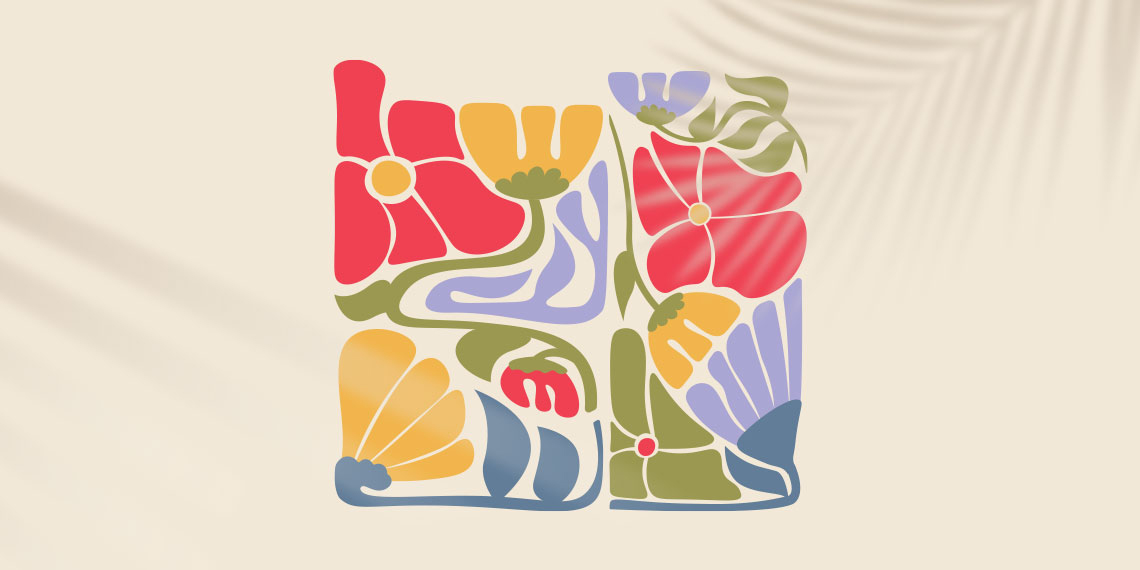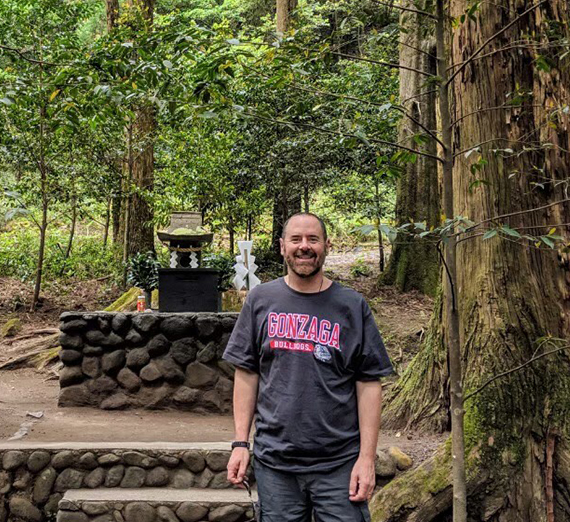Mindfulness: The Power of Stillness
Applications for Mindfulness in the Student Experience and in Life

In a sunlit room in the Hemmingson Center, I joined 20 or so graduate students who perched themselves on mats or cushions, settling into an experience of guided meditation. We were strangers from a variety of locations, industries and stations in life, gathered for a course that indicated we could become better leaders and healthier individuals.
The class was Mindfulness and Leadership, offered through Gonzaga’s School of Leadership Studies. And as is the case with other classes and activities bearing a focus on mindfulness, what students gained was a lasting gift of experiencing the power of stillness.
Mastery of Mindfulness
When Mike Hazel, professor in the graduate communications and leadership department, first proposed this course on mindfulness and leadership, he expected some questioning. Would there be enough academic rigor, especially for master’s and doctoral-level students?
He was prepared to answer.
“There’s plenty of hard science on the benefits of mindfulness, and data indicate its effects are meaningful,” he says, citing neuroplasticity and mindfulness-based stress-reduction therapies that have undergone plenty of research.
Hazel designed the course to be a “multisensory, experiential introduction to mindfulness supported by empirical research,” and included elements from Christian, contemplative and Eastern faith/philosophy traditions. “If one can integrate a practice that fits within their belief system, there is very clear evidence of significant positive effects,” he adds.
He would know.
Hazel first experienced formal meditation at age 26 when he began studying a martial art at a traditional dojo in Japan where an integrated practice was the norm. By his 40s, he was more consistent, and continues a regular practice today.
In his own words:
Reflection as a Cornerstone for Growth & Leadership
At Gonzaga, we speak of the five pillars of Ignatian pedagogy: context, experience, reflection, action and evaluation. The Jesuits are known for their commitment to reflection through the daily Examen and the Spiritual Exercises for Everyday Life.
Great value is placed on the practice of reflection in many other religious or philosophical traditions too. In some Native American cultures, there is the medicine wheel. In ancient European churches, the practice of the labyrinth. In Eastern contexts, meditation is key. All of these point to making time devoted to centering ourselves.
In the realm of leadership, mindfulness helps managers learn self-awareness and empathy for improving relationships. The act of listening, required for good leadership, is complex and requires self-regulation. Through mindfulness, you develop a stronger capacity for concentration, and this lends itself to so many uses – from running a meeting to building an environment of trust where people feel understood.
In meditation, we transcend thought to be present. Focus on the breath, acknowledge the sounds around us, refocus. These help us to harness the power of presence, and are useful techniques in so many settings, from athletic performance to addressing anxiety in public speaking.

Students Respond
Karla Parbon, adjunct dance instructor at Gonzaga, had degrees in psychology, women’s studies and theology when she began the Doctoral Program in Leadership Studies and enrolled in Hazel’s class.
She’d already been teaching yoga and meditation/mindfulness classes herself, but says she was curious about how he would incorporate intellectual inquiry with those practices.
“He did not disappoint,” she says. “This course gave us the permission to slow down, stop overthinking and just experience. Our cohort was a beautiful combination of beings at various levels of practicing mindfulness which presented an opportunity to learn and grow from one another.”
Another doctoral student, Laura Miner, a certified leadership development coach, said she enrolled in the course to help her return to a consistent practice of meditation, but also because she was curious about the benefits of mindfulness for leaders specifically.
She also uncovered additional resources to integrate into her work with clients. “In other words, this course had real-world implications that brought both personal and professional benefits,” Miner adds.
Meditation for the Practice of Psychology
For years, given strong empirical support, Professor Nancy Worsham has included mindfulness meditation practice in her psychology courses. Fifteen years ago, she added a targeted course, Mindfulness and Psychotherapy. Many of her former students – whose work spans many disciplines – share how that has made a difference in their careers. Here are a few examples from the psychology department’s website:
- Kayte Bradshaw (’12) completed clinical rotations at college counseling centers while completing her Ph.D. in counseling psychology. She employs a mindfulness-informed approach to care.
- Paul Condon (’09) conducts research on meditation and well-being, with a special interest in how meditation practices shape social behaviors such as compassion and forgiveness.
- Melissa Villeneuve (’14) is a mental health counselor who has enjoyed facilitating mindfulness groups.
As for Worsham herself: “Mindfulness practices have helped me navigate life challenges and be present and attuned to my students to engage them in learning.”
Inquiry into Buddhism
Gloria Chien teaches a Buddhist Meditation and Practice class that combines academic study with the act of meditation. She received funds to purchase 25 cushions and mats, which students use for contemplation sessions held in the Hearth Room, a quiet space near the University Chapel in College Hall. Here, she answers a few questions.
How would you describe the benefit of studying Buddhist meditation?
Buddhist meditation is one of the major religious contemplation practices, and its study promotes interreligious dialogue, for example, about traditions like Hindu mantra recitation, Tibetan Buddhist guru yoga, Catholic Lectio Divina (divine reading), the Ignatian Examen, etc.
How do you accommodate students who aren’t Buddhist?
Each contemplation activity is designed to be undertaken without needing a belief in Buddhism. The activities are influenced by my certification in the Cognitively-Based Compassion Training (CBCT®) developed at Emory University.
The combination of experiential learning and critical thinking is related to the texts we are studying, and students reflect on how their contemplation experience is different than the Buddhist meditation practice explained in the readings.
What do you hope students gain?
In addition to fostering intellectual growth, I hope the resiliency activities help students become more aware of their emotions and more skillful in regulating them. I want my students to increase their ethical concern for others – awareness of how their perspectives may cause them to judge or discriminate against others – and reflect on the root of their perspectives and adjust if desirable.

Tips for Beginning a Mindfulness Practice
From Mike Hazel
Have a dedicated “no-device time.” For me, it’s when I have my coffee. Just enjoy a few moments without any other distractions.
Try (and continue to practice) the “ambiance awareness” exercise. Right before entering a different space, whether a room or a building, take a moment at the doorway to get a sense of what the space feels like. Step through the doorway and note the change – the light, the temperature, how any subtle or obvious changes influence how you feel. With consistent practice, this helps develop your senses, brings you back to the now, and adds to to the enjoyment of life.
From Gloria Chien
Walk slowly in a quiet place focusing on the sensations of each step. Or, stand against the wall or sit on a chair. Through breathing, notice the rising and falling of your shoulders, back or stomach.
From the Author
Focus your commute. Even if you’re driving, you can practice being more aware of surroundings – not only the traffic around you, but the changes in the trees, or the progress on a construction project along the way. Really look at the people at stoplights: What might they be approaching in their lives today? Offer a kind smile or speak aloud a little blessing on their day.
From Karla Parbon
Start with the most universal and essential element of being human... your breath. Just take time to breathe deeply with honest intention to embrace what yoga describes as your pranayama or life source.
From Laura Miner
In the wise words of Nike, Just Do It. Implementing a mindfulness routine can happen in as few as five minutes a day, and the benefits continue to compound over time. Plus, in line with the Jesuit tradition of educating the whole person – body, mind and soul – mindfulness is a powerful technique for bringing all three into alignment.

From Smokiness to Clarity: Ministry and Mindfulness with Ben Chu
Eco-spirituality specialist and retreat leader Ben Chu (’21 M.A.) lives his dream job of taking people into the woods to grow closer to God. Working in Gonzaga’s Office of University Ministry, he coordinates camping trips, day hikes and other excursions for students who desire to feed their souls with experiences in nature.
A practicing Catholic, Chu once lived with a Soto Zen teacher and spent a month practicing Zazen (sitting meditation), which he continues to do amid his busy schedule today. While a philosophy and psychology student at the University of Oregon, he worked in a neuroscience lab where the Dalai Lama was a subject of scientific study of the impacts of meditation. Those experiences have played an integral role in facilitating retreats for students and navigating challenges.
Last fall, during the Gonzaga Out of Bounds (GOOB) program, wildfire smoke prevented students from having a typical outdoor excursion. “We were in Schoenberg with
100 students, unsure of what to do, and cortisol was high,” Chu recalls.
They could find indoor activities, like rock climbing, but also sought to feel as though they were truly in nature, as was the intention. Fortunately, Chu heard of Harmony Woods, a retreat center in the woods south of Spokane, co-founded by Fernando Ortiz, director of Gonzaga’s psychological services.
Inside Harmony Woods’ large yurt surrounded by trees, GOOB participants settled into yoga and meditation.
“It really helped to heal the anxiety and disappointment of these first-year students,” Chu says.

Breathing Together
While it’s true that meditation – like most things in our society – has been commodified through the selling of services and apps, the growing awareness and acceptance of mindfulness practices is encouraging.
I’ve witnessed a shifting openness to it in my workplace, the Marketing & Communications office at Gonzaga. Our former department leader began guiding our staff in centering ourselves with a few deep breaths together at Monday morning check-ins. For a while, I worried that some people may have been uncomfortable with this experience – the silence alone is hard for many.
But gradually, this time set aside for taking a deep breath and saying a prayer or reflecting on a prompt became normal, and we continue it under new leadership. There is certainly the risk of “going through the motions” as can be the case with any ritual. But sometimes our student workers participate, and we’ve heard comments from them, such as, “Wow, what a way to start the week.” It’s a good reminder that how we practice presence in our environment is another way to impact students’ overall learning in a positive way.
And that is worth another big, deep breath of gratitude.
- Academics
- Faith & Mission
- Health & Wellness
- School of Leadership Studies
- College of Arts & Sciences
- Gonzaga Magazine



